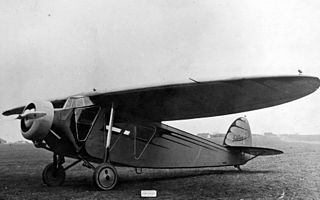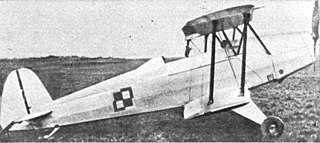Related Research Articles

PZL Mielec, formerly WSK-Mielec and WSK "PZL-Mielec" is a Polish aerospace manufacturer based in Mielec. It is the largest aerospace manufacturer in postwar Poland. In 2007, it was acquired by Sikorsky Aircraft Corporation, which retained the brand. Between 1948 and 2014, the company manufactured approximately 15,600 aircraft.
RWD was a Polish aircraft construction bureau active between 1928 and 1939. It started as a team of three young designers, Stanisław Rogalski, Stanisław Wigura and Jerzy Drzewiecki, whose names formed the RWD acronym.
Plage i Laśkiewicz was the first Polish aerospace manufacturer, located in Lublin and manufacturing aircraft under Lublin name. Full name was: Zakłady Mechaniczne E. Plage i T. Laśkiewicz – Mechanical Works E. Plage & T. Laśkiewicz. The factory produced aircraft between 1920 and 1935, when it was nationalized as the LWS.
LWS - Lubelska Wytwórnia Samolotów was a Polish aerospace manufacturer, located in Lublin, created in 1936 from Plage i Laśkiewicz works and produced aircraft between 1936 and 1939.

The Fokker F.VII, also known as the Fokker Trimotor, was an airliner produced in the 1920s by the Dutch aircraft manufacturer Fokker, Fokker's American subsidiary Atlantic Aircraft Corporation, and other companies under licence.

The PWS-24 was a Polish single-engine passenger aircraft for 4 passengers, built in PWS factory, used from 1933 to 1936 by LOT Polish Airlines. In spite of its limited capacity, it was the only series-built airliner of domestic design ever used by the LOT.
Podlaska Wytwórnia Samolotów (PWS) - Podlasie Aircraft Factory - was a Polish aerospace manufacturer between 1923 and 1939, located in Biała Podlaska.

The Lublin R-XVI was a Polish passenger and air ambulance aircraft, designed in the 1930s in the Plage i Laśkiewicz factory in Lublin and built in a small series.
The Lublin R-XX was the Polish torpedo bomber floatplane, designed in the early 1930s in the Plage i Laśkiewicz factory in Lublin. It remained a prototype.

The PZL.16 was a Polish passenger aircraft, designed in the early 1930s in the PZL in Warsaw. It remained a prototype.
This article is about the history of the Polish Air Force.

The PWS-21 was a Polish passenger aircraft for 4 passengers, built in PWS factory in 1930, that remained a prototype.

The PZL.4 was a Polish three-engine passenger aircraft for 10 passengers, built in PZL factory in 1932, which remained a prototype. It was the first Polish-designed and produced multi-engine plane.

The Lublin R-XI was the Polish passenger plane for 4 passengers, designed in 1930 in the Plage i Laśkiewicz factory in Lublin, that remained a prototype.

PZL-Świdnik S.A. is the biggest helicopter manufacturer in Poland. Its main products are PZL W-3 Sokół and PZL SW-4 Puszczyk helicopters. In early 2010 the factory was acquired by AgustaWestland, today Leonardo.
The Lublin R-XVIII was a Polish heavy bomber project, created by Jerzy Rudlicki of the Plage i Laśkiewicz factory in Lublin, based on the earlier unsuccessful Lublin R-VII Odwet design of 1924, following the specification for a "retribution bomber" by the Polish Ministry of Military Affairs.

The PWS-35 Ogar was a two-seat, aerobatic training biplane that was designed by Kazimierz Nowicki, Marian Piątka and Michał Rosnowski at the Lviv Polytechnic in 1935/1936.
Lublin R-VII Odwet was a Polish heavy bomber design created by the Plage i Laśkiewicz factory in Lublin. One of the first heavy aircraft under the Lublin brand, it was designed following a 1924 specification for a "retribution bomber" by the Polish Ministry of Military Affairs. The project, led by Jerzy Rudlicki was a trimotor high-wing mixed-construction aeroplane with heavy defensive armament. The design was submitted to the ministry in 1924, but it was lost by the mail service. As no Polish aircraft factory was deemed experienced enough to build large, complicated bombers, the newly created 2nd Destroyer Squadron of the 1st Air Regiment was equipped with 32 Farman Goliath bombers bought in France. No drawings of the R-VII have survived, but it is known that the later Lublin R-XVIII was based on it.
PWS-22, otherwise known as PWS-22BN3 was a Polish heavy bomber design created by Zbysław Ciołkosz and Antoni Uszacki of the Podlaska Wytwórnia Samolotów (PWS) factory in Biała Podlaska. Created in 1929 as a possible replacement for outdated Farman Goliath and improvised Fokker F.VII bombers in use by the Polish Army at the time, it was rejected along all other Polish designs.

PWS-40 Junak was a Polish trainer aircraft of the 1930s. First flown in the spring of 1939, it was to become the standard training aircraft of the Polish Air Force's fighter pilot schools before more advanced trainers could be delivered. However, due to the outbreak of World War II only the prototype was completed and test-flown.
References
- 1 2 3 "Samoloty firmy Plage&Laśkiewicz". www.jura-pilica.com (in Polish). Jura-Pilica. Retrieved 2013-07-02.
- ↑ Jerzy B. Cynk (1971). Polish Aircraft 1893–1939 . London: Putnam. ISBN 0-370-00085-4.
- 1 2 3 4 5 Janusz Dołęga. Monika Śliwińska (ed.). "Samoloty firmy Plage i Laśkiewicz". Leksykon Lublin (in Polish). Lublin: Ośrodek Brama Grodzka. Retrieved 2013-07-02.
- 1 2 3 4 5 6 7 8 9 10 11 Krzysztof Luto (2010). "PWS-23, 1929". Samoloty w Lotnictwie Polskim (in Polish). Suwałki.
- ↑ Krzysztof Luto (2010). "PWS-22B3N, 1929". Samoloty w Lotnictwie Polskim (in Polish). Suwałki.